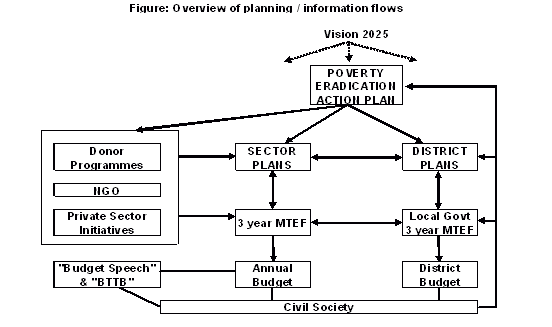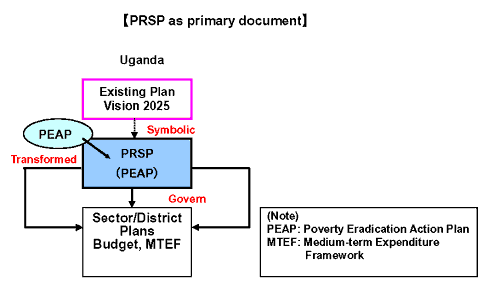 Uganda Poverty Eradication Action Plan (PEAP)
Uganda Poverty Eradication Action Plan (PEAP)
| Relationship with Existing Development Policies/Plans |
|
 Following the introduction of a series of structural adjustment measures started from 1987, The Government of Uganda (GoU) formulated a new national development plan Vision 2025 in 1999, which provides an overview of long-term goals and aspirations by the year 2025 ("Prosperous people, Harmonious nation and Beautiful country"). Following the introduction of a series of structural adjustment measures started from 1987, The Government of Uganda (GoU) formulated a new national development plan Vision 2025 in 1999, which provides an overview of long-term goals and aspirations by the year 2025 ("Prosperous people, Harmonious nation and Beautiful country").
 From 1995, with awareness of poverty eradication as the fundamental goal of the government, the process of formulating Poverty Eradication Action Plan (PEAP) was initiated in a participatory manner. The first PEAP was finalized in 1997 which establishes the policy framework for the eradication of poverty throughout 2017. In the case of Uganda, the revised PRSP serves as PRSP. From 1995, with awareness of poverty eradication as the fundamental goal of the government, the process of formulating Poverty Eradication Action Plan (PEAP) was initiated in a participatory manner. The first PEAP was finalized in 1997 which establishes the policy framework for the eradication of poverty throughout 2017. In the case of Uganda, the revised PRSP serves as PRSP.
 GoU introduced the Medium-Term Expenditure Framework (MTEF) in 1992/93. In parallel, efforts to develop sector plans and district plans (related to District MTEF) have been initiated, and the 1997 PEAP has guided the preparation of detailed sector plans. Also, Poverty Action Fund (PAF) was introduced in 1998 to channel resources for priority programs with direct poverty benefits. GoU introduced the Medium-Term Expenditure Framework (MTEF) in 1992/93. In parallel, efforts to develop sector plans and district plans (related to District MTEF) have been initiated, and the 1997 PEAP has guided the preparation of detailed sector plans. Also, Poverty Action Fund (PAF) was introduced in 1998 to channel resources for priority programs with direct poverty benefits.
 Uganda became a CDF pilot country in 1999. Uganda became a CDF pilot country in 1999.
|
| The Process of Formulation |
|
 Since 1999, GoU has been engaged in the process of revising the 1997 PEAP document, and its revision was completed in 2000. A summary of the revised PEAP was adopted as Uganda's PRSP. Since 1999, GoU has been engaged in the process of revising the 1997 PEAP document, and its revision was completed in 2000. A summary of the revised PEAP was adopted as Uganda's PRSP.
[note: PEAP is issued in three Volumes: Vol.1-Strategic Policy Framework, Vol. II-Public Investment Plan and Vol.III-Principles for Improved Partnerships. GoU plans to revise PEAP/PRSP biannually, drawing on the results of the Poverty Status Report which will also be prepared every two years.]
- 1998 April: Completion point of HIPC I (NPV $347 million of debt relief)
- 2000 February: HIPC II decision point
- 2000 March: Full PRSP (PEAP)
- 2000 May: HIPC II completion point (NPV $656 million of debt relief)
- 2001 March: 1st Progress Report of PRSP (PEAP)
|
| Strategic Priorities |
|
 The revised PEAP, or Uganda's PRSP places a greater emphasis than the 1997 document on the actions which contribute indirectly to poverty reduction, such as promote private sector development [PEAP p.3]. Its strategic public action is established on the following four pillars: The revised PEAP, or Uganda's PRSP places a greater emphasis than the 1997 document on the actions which contribute indirectly to poverty reduction, such as promote private sector development [PEAP p.3]. Its strategic public action is established on the following four pillars:
- Creating a framework for economic growth and transformation
- Ensuring good governance and security
- Directly increasing the ability of the poor to raise their incomes
- Directly increasing the quality of life of the poor
|
| Relationship with Budget System |
|
 The "figure: Overview planning/information flows" describes the relations between the PEAP/PRSP, other plans and policy documents. The "figure: Overview planning/information flows" describes the relations between the PEAP/PRSP, other plans and policy documents.
- PEAP/PRSP provides the framework for the development of detailed sector plans and investment. (National Plans for Road, Education, Health and Agriculture sectors had already been elaborated at the presentation of PEAP as PRSP in March 2000.)
- PEAP/PRSP and sector plans set the framework of the preparation of district plans which are still at an early stage of development.
- MTEF covers three fiscal years, and is intended to guide all public expenditures including the use of resources committed by donors. Since the introduction of PEAP/PRSP, GoU has utilized MTEF to allocate resources and better align the spending priorities articulated in PEAP/PRSP and in sector and district plans. MTEF and the annual Budget Framework Paper (BFP) are the mechanism through which the long-term goals of PEAP/PRSP are translated into actions over the medium-term, disciplined by the hard budget constrains. The roads, education, health, and water and sanitation sectors have already introduced output and outcome measures in their BFP for 2001/02-2002/03.
- Since 1998, the institution of the Poverty Action Fund (PAF) has been used to ensure that the planned reallocations directly benefit the poor. The share of the PAF in total public expenditure has increased from 24% in 1999/2000 to 31 % in 2000/01. (Originally, PAF was intended to ensure that resources saved from HIPC debt relief were spent on priority programs, but subsequently it has become a mechanism for allocating the incremental expenditures for poverty reducing activities specified in PEAP/PRSP.)
|
| Aid Modality |
|
 PEAP/PRSP clearly stated that international aid is desired to be channeled by modalities such as common pool and budgetary support as quoted below: PEAP/PRSP clearly stated that international aid is desired to be channeled by modalities such as common pool and budgetary support as quoted below:
- The Government is introducing a sector-wide approach wherever feasible, under which government and donors contribute to a common pool of resources used to achieve the sectoral objectives. The flexibility which this arrangement allows is essential to the efficient use of public expenditure, because only in a sector-wide approach can the overall implications of a national programme within each sector be considered, and because a sector-wide approach can reduce duplications of effort by different projects and divergences of cost structure between projects and other public activities [PEAP p.19].
- It is therefore clear that far from making fungibility easier, the injection of budget support through the PAF mechanism allows a more transparent understanding of the additionality of donor resources than was ever possible with the funding of individual projects[PEAP p.21].

| Quick guide to planning processes |
| Vision 2025: |
an overview of long term goals and aspirations by the year 2025 |
| The PEAP: |
the national planning framework on which to develop detailed sector strategies |
| Sector Planning: |
technical specifications of sector priorities, disciplined by hard budget constraints |
| District Planning: |
implementation plans for sector strategies based on local priorities / needs |
| MTEF: |
annual, rolling 3 year expenditure planning, setting out the medium term expenditure priorities and hard budget constraints against which sector plans can be developed and refined |
| District MTEF: |
setting out the medium term expenditure priorities and hard budget constraints Against which district plans can be developed and refined |
| Annual Budget & District Budgets: |
annual implementation of the three year planning framework Donor; NGO; private sector: participating and sharing information / ideas in developing sector plans and budgets |
| Participatory processes: |
bottom-up participation of districts in the planning and monitoring process, as well as participatory poverty assessments, providing essential feedback on progress towards poverty eradication goals |
| Source: |
Ministry of Finance, Planning and Economic Development [2000], Poverty Reduction Strategy Paper, Uganda's Poverty Eradication Action Plan, Summary and Main Objectives. March, P.4. |

|
| References |
| Ministry of Finance, Planning and Economic Development [2000], Poverty Reduction Strategy Paper, Uganda's Poverty Eradication Action Plan, Summary and Main Objectives. March. [http://poverty.worldbank.org/files/Uganda%20IPRSP.pdf].
Ministry of Finance, Planning and Economic Development [2001], Poverty Reduction Strategy Paper, Progress Report 2001: Uganda Poverty Status Report 2001 Summary. March. [http://poverty.worldbank.org/files/uganda%20ppr.pdf].
IMF and IDA [2001], "Uganda: Poverty Reduction Strategy Paper Progress Report, Joint Staff Assessment" March 9. [http://poverty.worldbank.org/files/ugandajsa.pdf].
*This note was written by GRIPS Development Forum, based on Ministry of Finance, Planning and Economic Development [2000].
|

